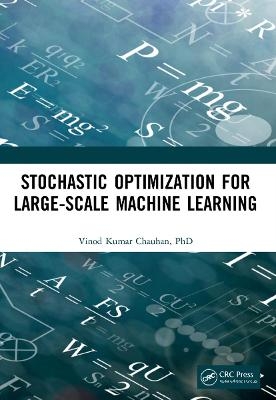
Stochastic Optimization for Large-scale Machine Learning
CRC Press (Verlag)
978-1-032-14614-0 (ISBN)
Stochastic Optimization for Large-scale Machine Learning identifies different areas of improvement and recent research directions to tackle the challenge. Developed optimisation techniques are also explored to improve machine learning algorithms based on data access and on first and second order optimisation methods.
Key Features:
Bridges machine learning and Optimisation.
Bridges theory and practice in machine learning.
Identifies key research areas and recent research directions to solve large-scale machine learning problems.
Develops optimisation techniques to improve machine learning algorithms for big data problems.
The book will be a valuable reference to practitioners and researchers as well as students in the field of machine learning.
Dr. Vinod Kumar Chauhan is a Research Associate in Industrial Machine Learning in the Institute for Manufacturing, Department of Engineering at University of Cambridge UK. He has a PhD in Machine Learning from Panjab University Chandigarh India. His research interests are in Machine Learning, Optimization and Network Science. He specializes in solving large-scale optimization problems in Machine Learning, handwriting recognition, flight delay propagation in airlines, robustness and nestedness in complex networks and supply chain design using mathematical programming, genetic algorithms and reinforcement learning.
List of Figures
List of Tables
Preface
Section I BACKGROUND
Introduction
1.1 LARGE-SCALE MACHINE LEARNING
1.2 OPTIMIZATION PROBLEMS
1.3 LINEAR CLASSIFICATION
1.3.1 Support Vector Machine (SVM)
1.3.2 Logistic Regression
1.3.3 First and Second Order Methods
1.3.3.1 First Order Methods
1.3.3.2 Second Order Methods
1.4 STOCHASTIC APPROXIMATION APPROACH
1.5 COORDINATE DESCENT APPROACH
1.6 DATASETS
1.7 ORGANIZATION OF BOOK
Optimisation Problem, Solvers, Challenges and Research Directions
2.1 INTRODUCTION
2.1.1 Contributions
2.2 LITERATURE
2.3 PROBLEM FORMULATIONS
2.3.1 Hard Margin SVM (1992)
2.3.2 Soft Margin SVM (1995)
2.3.3 One-versus-Rest (1998)
2.3.4 One-versus-One (1999)
2.3.5 Least Squares SVM (1999)
2.3.6 v-SVM (2000)
2.3.7 Smooth SVM (2001)
2.3.8 Proximal SVM (2001)
2.3.9 Crammer Singer SVM (2002)
2.3.10 Ev-SVM (2003)
2.3.11 Twin SVM (2007)
2.3.12 Capped lp-norm SVM (2017)
2.4 PROBLEM SOLVERS
2.4.1 Exact Line Search Method
2.4.2 Backtracking Line Search
2.4.3 Constant Step Size
2.4.4 Lipschitz & Strong Convexity Constants
2.4.5 Trust Region Method
2.4.6 Gradient Descent Method
2.4.7 Newton Method
2.4.8 Gauss-Newton Method
2.4.9 Levenberg-Marquardt Method
2.4.10 Quasi-Newton Method
2.4.11 Subgradient Method
2.4.12 Conjugate Gradient Method
2.4.13 Truncated Newton Method
2.4.14 Proximal Gradient Method
2.4.15 Recent Algorithms
2.5 COMPARATIVE STUDY
2.5.1 Results from Literature
2.5.2 Results from Experimental Study
2.5.2.1 Experimental Setup and Implementation Details
2.5.2.2 Results and Discussions
2.6 CURRENT CHALLENGES AND RESEARCH DIRECTIONS
2.6.1 Big Data Challenge
2.6.2 Areas of Improvement
2.6.2.1 Problem Formulations
2.6.2.2 Problem Solvers
2.6.2.3 Problem Solving Strategies/Approaches
2.6.2.4 Platforms/Frameworks
2.6.3 Research Directions
2.6.3.1 Stochastic Approximation Algorithms
2.6.3.2 Coordinate Descent Algorithms
2.6.3.3 Proximal Algorithms
2.6.3.4 Parallel/Distributed Algorithms
2.6.3.5 Hybrid Algorithms
2.7 CONCLUSION
Section II FIRST ORDER METHODS
Mini-batch and Block-coordinate Approach
3.1 INTRODUCTION
3.1.1 Motivation
3.1.2 Batch Block Optimization Framework (BBOF)
3.1.3 Brief Literature Review
3.1.4 Contributions
3.2 STOCHASTIC AVERAGE ADJUSTED GRADIENT (SAAG) METHODS
3.3 ANALYSIS
3.4 NUMERICAL EXPERIMENTS
3.4.1 Experimental setup
3.4.2 Convergence against epochs
3.4.3 Convergence against Time
3.5 CONCLUSION AND FUTURE SCOPE
Variance Reduction Methods
4.1 INTRODUCTION
4.1.1 Optimization Problem
4.1.2 Solution Techniques for Optimization Problem
4.1.3 Contributions
4.2 NOTATIONS AND RELATED WORK
4.2.1 Notations
4.2.2 Related Work
4.3 SAAG-I, II AND PROXIMAL EXTENSIONS
4.4 SAAG-III AND IV ALGORITHMS
4.5 ANALYSIS
4.6 EXPERIMENTAL RESULTS
4.6.1 Experimental Setup
4.6.2 Results with Smooth Problem
4.6.3 Results with non-smooth Problem
4.6.4 Mini-batch Block-coordinate versus mini-batch setting
4.6.5 Results with SVM
4.7 CONCLUSION
Learning and Data Access
5.1 INTRODUCTION
5.1.1 Optimization Problem
5.1.2 Literature Review
5.1.3 Contributions
5.2 SYSTEMATIC SAMPLING
5.2.1 Definitions
5.2.2 Learning using Systematic Sampling
5.3 ANALYSIS
5.4 EXPERIMENTS
5.4.1 Experimental Setup
5.4.2 Implementation Details
5.4.3 Results
5.5 CONCLUSION
Section III SECOND ORDER METHODS
Mini-batch Block-coordinate Newton Method
6.1 INTRODUCTION
6.1.1 Contributions
6.2 MBN
6.3 EXPERIMENTS
6.3.1 Experimental Setup
6.3.2 Comparative Study
6.4 CONCLUSION
Stochastic Trust Region Inexact Newton Method
7.1 INTRODUCTION
7.1.1 Optimization Problem
7.1.2 Solution Techniques
7.1.3 Contributions
7.2 LITERATURE REVIEW
7.3 TRUST REGION INEXACT NEWTON METHOD
7.3.1 Inexact Newton Method
7.3.2 Trust Region Inexact Newton Method
7.4 STRON
7.4.1 Complexity
7.4.2 Analysis
7.5 EXPERIMENTAL RESULTS
7.5.1 Experimental Setup
7.5.2 Comparative Study
7.5.3 Results with SVM
7.6 EXTENSIONS
7.6.1 PCG Subproblem Solver 1
7.6.2 Stochastic Variance Reduced Trust Region Inexact Newton Method
7.7 CONCLUSION
Section IV CONCLUSION
Conclusion and Future Scope
8.1 FUTURE SCOPE 142
Bibliography
Index
| Erscheinungsdatum | 04.11.2021 |
|---|---|
| Zusatzinfo | 4 Tables, black and white; 25 Line drawings, black and white; 25 Illustrations, black and white |
| Verlagsort | London |
| Sprache | englisch |
| Maße | 178 x 254 mm |
| Gewicht | 326 g |
| Themenwelt | Informatik ► Theorie / Studium ► Künstliche Intelligenz / Robotik |
| Mathematik / Informatik ► Mathematik ► Angewandte Mathematik | |
| Mathematik / Informatik ► Mathematik ► Finanz- / Wirtschaftsmathematik | |
| ISBN-10 | 1-032-14614-1 / 1032146141 |
| ISBN-13 | 978-1-032-14614-0 / 9781032146140 |
| Zustand | Neuware |
| Informationen gemäß Produktsicherheitsverordnung (GPSR) | |
| Haben Sie eine Frage zum Produkt? |
aus dem Bereich


